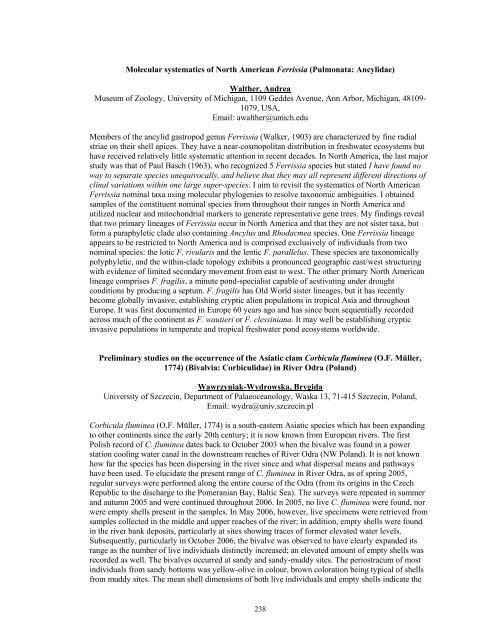World Congress of Malacology Antwerp ... - Unitas Malacologica
World Congress of Malacology Antwerp ... - Unitas Malacologica
World Congress of Malacology Antwerp ... - Unitas Malacologica
You also want an ePaper? Increase the reach of your titles
YUMPU automatically turns print PDFs into web optimized ePapers that Google loves.
Molecular systematics <strong>of</strong> North American Ferrissia (Pulmonata: Ancylidae)<br />
Walther, Andrea<br />
Museum <strong>of</strong> Zoology, University <strong>of</strong> Michigan, 1109 Geddes Avenue, Ann Arbor, Michigan, 48109-<br />
1079, USA,<br />
Email: awalther@umich.edu<br />
Members <strong>of</strong> the ancylid gastropod genus Ferrissia (Walker, 1903) are characterized by fine radial<br />
striae on their shell apices. They have a near-cosmopolitan distribution in freshwater ecosystems but<br />
have received relatively little systematic attention in recent decades. In North America, the last major<br />
study was that <strong>of</strong> Paul Basch (1963), who recognized 5 Ferrissia species but stated I have found no<br />
way to separate species unequivocally, and believe that they may all represent different directions <strong>of</strong><br />
clinal variations within one large super-species. I aim to revisit the systematics <strong>of</strong> North American<br />
Ferrissia nominal taxa using molecular phylogenies to resolve taxonomic ambiguities. I obtained<br />
samples <strong>of</strong> the constituent nominal species from throughout their ranges in North America and<br />
utilized nuclear and mitochondrial markers to generate representative gene trees. My findings reveal<br />
that two primary lineages <strong>of</strong> Ferrissia occur in North America and that they are not sister taxa, but<br />
form a paraphyletic clade also containing Ancylus and Rhodacmea species. One Ferrissia lineage<br />
appears to be restricted to North America and is comprised exclusively <strong>of</strong> individuals from two<br />
nominal species: the lotic F. rivularis and the lentic F. parallelus. These species are taxonomically<br />
polyphyletic, and the within-clade topology exhibits a pronounced geographic east/west structuring<br />
with evidence <strong>of</strong> limited secondary movement from east to west. The other primary North American<br />
lineage comprises F. fragilis, a minute pond-specialist capable <strong>of</strong> aestivating under drought<br />
conditions by producing a septum. F. fragilis has Old <strong>World</strong> sister lineages, but it has recently<br />
become globally invasive, establishing cryptic alien populations in tropical Asia and throughout<br />
Europe. It was first documented in Europe 60 years ago and has since been sequentially recorded<br />
across much <strong>of</strong> the continent as F. wautieri or F. clessiniana. It may well be establishing cryptic<br />
invasive populations in temperate and tropical freshwater pond ecosystems worldwide.<br />
Preliminary studies on the occurrence <strong>of</strong> the Asiatic clam Corbicula fluminea (O.F. Müller,<br />
1774) (Bivalvia: Corbiculidae) in River Odra (Poland)<br />
Wawrzyniak-Wydrowska, Brygida<br />
University <strong>of</strong> Szczecin, Department <strong>of</strong> Palaeoceanology, Waska 13, 71-415 Szczecin, Poland,<br />
Email: wydra@univ.szczecin.pl<br />
Corbicula fluminea (O.F. Müller, 1774) is a south-eastern Asiatic species which has been expanding<br />
to other continents since the early 20th century; it is now known from European rivers. The first<br />
Polish record <strong>of</strong> C. fluminea dates back to October 2003 when the bivalve was found in a power<br />
station cooling water canal in the downstream reaches <strong>of</strong> River Odra (NW Poland). It is not known<br />
how far the species has been dispersing in the river since and what dispersal means and pathways<br />
have been used. To elucidate the present range <strong>of</strong> C. fluminea in River Odra, as <strong>of</strong> spring 2005,<br />
regular surveys were performed along the entire course <strong>of</strong> the Odra (from its origins in the Czech<br />
Republic to the discharge to the Pomeranian Bay, Baltic Sea). The surveys were repeated in summer<br />
and autumn 2005 and were continued throughout 2006. In 2005, no live C. fluminea were found, nor<br />
were empty shells present in the samples. In May 2006, however, live specimens were retrieved from<br />
samples collected in the middle and upper reaches <strong>of</strong> the river; in addition, empty shells were found<br />
in the river bank deposits, particularly at sites showing traces <strong>of</strong> former elevated water levels.<br />
Subsequently, particularly in October 2006, the bivalve was observed to have clearly expanded its<br />
range as the number <strong>of</strong> live individuals distinctly increased; an elevated amount <strong>of</strong> empty shells was<br />
recorded as well. The bivalves occurred at sandy and sandy-muddy sites. The periostracum <strong>of</strong> most<br />
individuals from sandy bottoms was yellow-olive in colour, brown coloration being typical <strong>of</strong> shells<br />
from muddy sites. The mean shell dimensions <strong>of</strong> both live individuals and empty shells indicate the<br />
238



